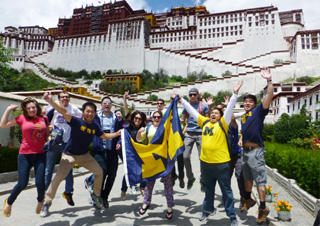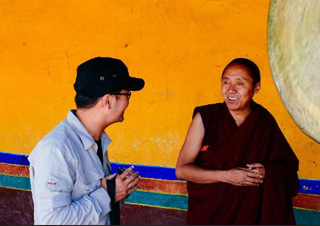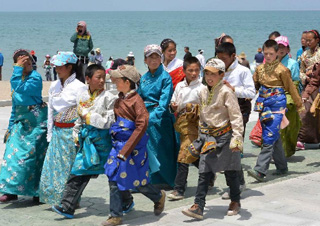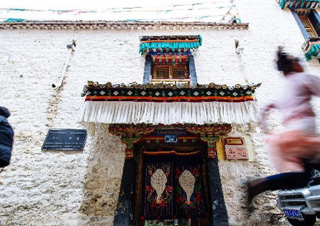10 Days Chengdu – Xining – Lhasa Tour by Train
Tour Type: Private Tour: Flexible Travel Date & Travel Routes
Guide & Driver: Chinese-English-speaking guide & air-conditioned
Tour Highlights:
B-- Breakfast L-- Lunch D-- Dinner
-
Day 1 Chengdu Arrival
Welcome to the hometown of Giant Panda! Upon arriving at the airport/train station, you will be met by your local tour guide, and then drive to your downtown hotel in Chengdu City. After the hotel check-in, you are free to take a rest or explore around on your own.
Optional Activity: go to enjoy an authentic Sichuan Cuisine dinner at a local restaurant.
Accommodation:
-
Day 2 Chengdu ( B, L )
Chengdu has three famous features - Giant Panda, History and Leisure Living Pace. Today, you will go to explore these tree features one by one. First is to visit the lovely Giant Pandas in Chengdu Research Base of Giant Panda Breeding, which is the No. 1 thing to do in Chengdu. You will leave your hotel early and drive about 30 minutes to the panda base so that you can catch up the great moments of pandas, such as feeding, playing, climbing tree, etc. There are different enclosures for pages of different ages, such as all around to see baby pandas, 1 year-old pandas, teenage pandas, and older pandas. Beautiful walking paths will lead you to visit the enclosures from one to next. Enjoy the happy time with pandas.
The second place to visit is the sacred Wenshu Temple which is hidden peacefully among the modern mansions. This temple is the most popular Buddhist temple in Chengdu region. It has beautiful traditional ancient architecture. The atmosphere is calm and quiet, some people are praying. There is a little garden and the monastery is very colorful and decorated.
Lastly, you are going to explore the leisure living peace of locals at Renmin Park and Jinli Street. Renmin Park, or People’s Park is the place for locals to go for a relaxing walk, meet friends, or have a cup of tea. While Jinli is the “street of tourists”. You can wander on the traditional old street to absorb the special atmosphere of Chengdu, taste local snacks, watching a performance, etc.
Optional Recommended Night Activity: watch an fascinating show of traditional Sichuan Opera & Face Changing Performance in a local theatre.
Accommodation:
-
Day 3 Flight to Xining from Chengdu ( B )
Today, you will visit the Dufu Thatched Cottage which is a museum in honor of Dufu (712 -770 AD), who was the greatest realist poet and has been famed as the Sage of Poetry.
After lunch, your tour guide will escort you to the airport for your flight to Xining.
Accommodation:
-
Day 4 Xining ( B )
After breakfast, drive around 2.5 hours to the Qinghai Lake which is the best highlights of your Qinghai tour.
Qinghai Lake is surrounded by high mountains from outside. And on the foot of mountains it is endless beautiful grasslands. So you can enjoy the great views by walking, riding or biking. Qinghai Lake is the paradise for birds, which can amount to more than 10 thousand in the summer.
Cruise on the lake and visit the Bird Island in the lake. On route, you will also visit the Riyue Mountains (Sun and Moon Mountains) and the Ri Pagoda and Yue Pagoda which hich were built in Tang Dynasty to commemorate the intermarriage of marrying Princess Wencheng of Tang to Tubo. In nearby, you will also be amazed by the Daotang River which flows oppositely.
Go back Xining and stay overnight.
Accommodation:
-
Day 5 Train to Lhasa ( B )
After breakfast, drive about 26km to visit the famous Taer Monastery.
Taer Monastery is the birthplace of the Tibetan Buddhism master – Tsongkhapa who was the founder of Gelug(a sect of Buddhism). It is also famous as one of “Six Gelug Monasteries”. You must not miss the “three bests” of Taer Monastery – murals, barbola and butter sculptures. Taer Monastery is also a very important institute to learn Buddhism, Astronomy and Medicine. There are many Buddhist ceremonies organized here in each year.
Get back to Xining city for the train to Tibet. Enjoy the fantastic plateau views along this highest railway in the world.
Accommodation:
-
Day 6 Lhasa Arrival ( B )
Witness the beautiful Tibetan Plateau with groups of nomads. See the Kekexili Nature Reserve which protects wild plants and animals as well as their natural habitates.
Once arrival at Lhasa, you will be picked up by local tour guide at the train station, then be escorted to your hotel in Lhasa city in a private vehicle.
After arrival at your hotel, the rest of the day is free for you to explore the local areas and acclimatize yourself to the air, temperature and high altitude of Lhasa.
High Altitude Acclimation Tips:1) go for some leisure walking to acclimate the high altitude but avoid strenuous activity after arrival; 2) you'd better not have bath, in case of catching a cold; 3) drink more water, and have some fruit; 4) have a good rest.
Accommodation:
-
Day 7 Lhasa ( B )
Start today’s Lhasa exploration with an exciting visit to the landmark - Potala Palace which is regarded as one of the most beautiful architectural building in the world. You will climb up the palace along the zigzag stone paths with white-and-red walls to the top of the palace where you can not only appreciate the exotic Tibetan-style architecture, but also get a great view of Lhasa’s urban areas, then walk into the inner space of Potala Palace to explore the stately chapels and learn about the history of the palace.
Continuing your exploration, you will then get to Jokhang Temple which is considered as the spiritual heart of Tibetan Buddhism. Each day, there are thousands of pilgrims coming from different places in Tibet to the temple to worship to the Buddha. This temple is also known as the “house of Buddha” because it keeps the precious Jowo Rinpoche, the life-sized (5 foot/1.5m) image of the Shakyamuni at the age of 12. The last site for today’s exploration is the famous Barkor Street. It is a circular and wide street encircling the Jokhang Temple. The local people like to walk on the street for several circles usually in the late afternoon as a daily tradition of pilgrimage. The street also has many shops selling a wide variety of traditional Tibetan goods, religious items and handcrafts.
Tips of today: 1) there are 1,080 steps up to climb to the top of Potala Palace, so don’t walk in a rush, which may cause high altitude sickness; 2) taking photos is not allowed inside the palace; 3) today you will be mainly outside, please bring some water, a hat, sun cream, and sun glasses with you.
Accommodation:
-
Day 8 Lhasa ( B )
After breakfast, you will firstly go to visit the beautiful Norbulingka which used to be the former summer palace of Dalai Lamas in the ancient time, and now is a public park. It is famous for its Potrang, the private palaces of former Dalai lamas with grandiose Tibetan architecture style. Next, drive several kilometers to the western outskirts of Lhasa to visit Drepung Monastery. Drepung, in Tibetan, means “prosperity”. Since its establishment, Drepung Monastery has always been one of the most important Buddhist monasteries in Tibet. In its heyday, there were more than 10,000 monks lived and studied in the monastery. Throughout its history, many important and famous Tibetan leaders used to study here, especially the Dalai Lamas. So Drepung Monastery is also respectfully known as the “Mother School of Dalai Lamas”.
In the afternoon, you will be taken to another famous monastery in Lhasa - Sera Monastery. It is famous for the spectacular “Buddhism Debating”. As a daily routine, the monks gather in a courtyard, and debate on the Buddhist doctrines with supplemented gestures, which is thought to be helpful to facilitates better comprehension of the Buddhist philosophy to attain higher levels of study. After enjoying the "Buddhism Debating", you will be transferred back to the city. The rest time is your own free time to rest.
The Etiquette of Visiting Monastery: 1) you shouldn’t wear short and uncover shoulders; 2) taking off your sunglasses and hat before entering the chapels; 3) taking photos is usually not allowed inside the chapels.
Accommodation:
-
Day 9 Lhasa – Namtso Lake ( B )
Want to explore some other features of Tibet instead of the monasteries? Let's take an exciting trip to the holy lake Namtso which is about 5 hours driving from Lhasa City. You will arrive at Namtso Lake around the early afternoon. Take some rest and throw yourself into the incredible landscape of holy lake.
Namtso Lake is the highest saltwater lake in the world with an altitude of 4718 meters, also the second largest saltwater lake in China (after the Qinghai Lake). It’s quite common for tourists who are awestruck at the Namtso at the first sight. With the snowy mountains in the background, the crystal-clear dazzling blue water, Namtso is stretching to the horizon. In clear days, the lake looks like a beautiful turquoise surrounded by magnificent snow-capped Tanggula Mountains, and the lakeshore is green, wide and open, dotted with tents, yaks and sheep of local nomads. For travelers, Namtso is the ideal place for photography, while for Tibetans, it is a scared and magical lake for pilgrimage.
Lastly, drive back to Lhasa for accommodation.
Tips of today: 1) the altitudes of Namtso Lake region is about 5, 000 meters, so you should be fully prepared for high altitude sickness. Do remember to keep warm all the time and avoid strenuous activity; 2) if you want to spend longer time and watch sunset and sunrise, you can also accommodate at Namtso for a night, but the accommodation condition is very basic, so is the food supply.
Accommodation:
-
Day 10 Lhasa Departure ( B )
Today is free for you until your tour guide transfer you to the airport in time for your flight or drop you off at Lhasa train station.
Tips of Today: 1) please pack your luggage carefully, especially for small things like camera charger, power adaptor, mobile phone, phone charger, wallet and towel; 2) if your flight is arranged in the afternoon, please make sure you check out the hotel before 12pm.
Accommodation:
- Airfare from Chengdu to Lhasa.
- Private professional English-speaking tour guide.
- Private vehicle and Luggage Transfers.
- All necessary Tibet travel permits.
- All accommodations, based on double-occupancy. Medium standard accommodation with attached bathroom on twin sharing basis. Guesthouse or tent in remote areas.
- Meals noted in the itinerary as "B,L,D".
- Admission fees and activity expenses, as noted in the itinerary.
- Service Charge (the planning, handling, operational and communication charges) & government taxes.
- Tourists Accident/Casualty Insurance
- China visa.
- Sightseeing not listed in the itinerary.
- Meals not listed in the itinerary.
- Personal expenses such as laundry, drink, fax, telephone call, optional tour activities, etc.
- Gratuities, tips to guides, drivers, bellboys, etc.
- Excess Baggage Charges.
- Single room supplement.
- Additional tour service and/or activities.
Why Travel With Us.
-
Bigger savings on transportation, accommodation, tickets and tour packages.
Scoring a massive discount on early-bird booking. -
24/7 professional customer services provided by trained travel consultants
One-stop support for travel documents application, tickets booking and problem solving through the tour- 100% train tickets guaranteed in the past 10 years.
Over 60% of regular customers and returning customers come back to travel with us. -
Genuine touch and taste of the local sceneries, culture and food.
Non-shopping private trips of exploring and discovering an authentic Tibet. -
Experienced drivers & tour guides to ensure your tour to be safe and fun.
Custom tailored package to meet your needs across a wide range of levels travelling.
Complete and considerate returns, refund and exchange policies help you to prevent and minimize travel risk.
Itineraries you may also like:
-
 6-Day Tibet Holy City Train Tour
6-Day Tibet Holy City Train Tour
-
 7 Days Overland Tour from Kathmandu to Lhasa
7 Days Overland Tour from Kathmandu to Lhasa
-
 8 Days Kathmandu to Lhasa Tour by Flight
8 Days Kathmandu to Lhasa Tour by Flight
-
 12 Days Xi’an – Lhasa – EBC – Lhasa Trip
12 Days Xi’an – Lhasa – EBC – Lhasa Trip
-
 9 Days Nepal Bhutan Cultural Tour
9 Days Nepal Bhutan Cultural Tour
-
 5 Days Lhasa Winter Tour to Ganden Monastery
5 Days Lhasa Winter Tour to Ganden Monastery
-
 12-Day in-Depth Nepal overland Tour
12-Day in-Depth Nepal overland Tour
-
 9 Days Train Tour from Xining to Lhasa
9 Days Train Tour from Xining to Lhasa
-
 8 Days Nyingchi Peach Blossom Festival Tour
8 Days Nyingchi Peach Blossom Festival Tour
Quick Question
(age 12+):
- 1
- 2
- 3
- 4
- 5
- 6
- - Title -
- Mr
- Ms
Why Choose Us
- Reply within 24 hours
Personalized trip proposal
Price quote
- 100% tailor-made trip
Satisfaction guaranteed trip plan
Flexible travel date
- Worry-Free vacation
Private guide & car
24/7 customer care








 Data in submission...
Data in submission...


